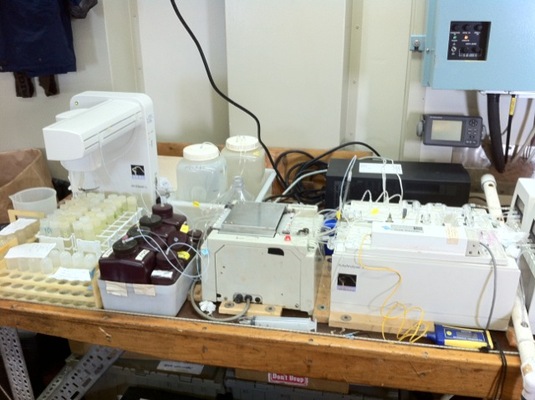
by Jeremy Jacquot Friday, January 20, 2012

Trace metal sampling equipment. Jeremy Jacquot
The inspection of the faulty drive shaft confirmed the worst of the engineers’ fears: The GEOTRACES cruise would have to end early.
With only a few precious days of sampling left before we would have to pack it all in, we made haste to the last four sampling stops situated off the coast of Mauritania.
The Mauritanian section was of particular interest to scientists on the GEOTRACES cruise because it offered a tantalizing opportunity to study how biological and physical processes such as upwelling and the advection of particulate matter from the continental shelf affect the distributions of trace elements. The section is also close to the vast Saharan desert, and the team wanted to quantify how dust storms affect trace element concentrations in the surface waters of the ocean, as well as how the additions of dust to the ocean promote the sinking of larger particles to deeper waters.
It was also (unfortunately) the perfect spot from which to study the abundance and diversity of African insects, which were carried to our ship by the winds.
So what did we discover?
Well, we measured extremely high levels of aluminum and iron in the surface waters — as you would expect in an area with heavy dust deposition. We saw other tell-tale signs of elevated primary production (phytoplankton blooms and high nutrient concentrations), also consistent with an upwelling region.
The CTD’s dissolved oxygen data also revealed the presence of an oxygen minimum zone at depth, another indicator of significant primary production. Oxygen minimum zones form when organic matter from the surface of the ocean — the remains of dead diatoms, cyanobacteria and other primary producers — sinks to the depths and is consumed by dense aggregations of microbes, which also consume significant amounts of oxygen in the process.
The rest of our findings will have to wait until those of us with data- and/or instrumentation-heavy techniques can return to our labs and conduct the necessary analyses.
Being on a ship, albeit a very large and well-equipped one, you can only ever do so much — although what we can do has grown by leaps and bounds since the days of GEOSECS and other pioneering oceanographic research programs. In recent years especially, shipboard analyses of nutrients, including phosphates and nitrates, and trace metals, including iron and zinc, have become incredibly accurate and relatively simple — sometimes taking as little as half an hour to make. But until somebody finds a way to shrink the hulking mass spectrometers that many of us rely on for our measurements to a convenient size, we’ll have to get by with storing our samples and waiting. And while nobody likes waiting (scientists included), it’s exciting to think that our most interesting results have yet to emerge.
Several days and countless samples later, during which we must have collected hundreds of liters of seawater from dozens of depths, we ended the science portion of the cruise. Having obtained samples from 12 of the roughly 36 stops we had hoped to get to during the cruise, we were thrilled with the progress we’d made — but obviously disappointed by the fact that we would have to wait until at least some time next year to continue on.
As I write this, I, like many of my colleagues, am sitting at my desk, having just finished the long trip back home. And though I feel as though the events of the past two weeks still haven’t fully sunk in, I am still hopeful about the GEOTRACES program and about the many things we will learn about the oceans and climate through it.
© 2008-2021. All rights reserved. Any copying, redistribution or retransmission of any of the contents of this service without the expressed written permission of the American Geosciences Institute is expressly prohibited. Click here for all copyright requests.